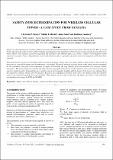| dc.description.abstract | Safety zone determination for wireless cellular towers has attracted attention from many researchers in the last decade. This is caused by the rapid growth of the wireless cellular industry which has led to the installation of towers even in the residential areas. There are many reports and ongoing researches regarding the biological and thermal effects of wireless cellular electromagnetic fields exposures to people. Cancer, hyperthermia, neural and behaviour effects of people exposed to these electromagnetic fields have been reported. This motivates the research to determine safety zones from wireless cellular towers to assure safety to those living in the vicinity of these towers. A model for safety zone determination is developed. The model takes the received power at the object, power transmitted by the transmitter and gain of the transmitter as inputs to determine the safe distance from the radiation of a wireless cellular transmitter. The power density received by the object and its geographical location from the radiation source are measured using the selective radiation meter. Transmitted power and the gain of the transmitter together with the height of the tower were obtained from the respective wireless cellular network operator. Based on the geographical location of the object, the distance from the radiation source was calculated using the haversine formula. These inputs are then used to determine the safety zone based on the standards and guidelines developed by WHO and ICNIRP. | en_US |

